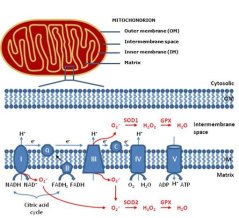
Project
Restoring redox balance to improve mitochondrial health and prevent metabolic complications
The number of obese and aged individuals is rapidly increasing worldwide. Consequently, obesity and aging-related metabolic complications have become major health concerns, both from a societal and economical point of view. There is no doubt that extensive research is needed to understand the underlying pathophysiology and ultimately develop intervention strategies that will strengthen our health.

Adenosine-tri-phosphate (ATP) is the form in which energy is used in the cells of our body. ATP is generated through cellular respiration in mitochondria, making these cell organelles important for cellular metabolism. Humans produce roughly 40-80 kg of ATP per day, depending on whether they are in rest or physically active. To produce these huge amounts of ATP, mitochondria use approximately 90% of the consumed oxygen. Besides this bioenergetic role, mitochondria harbour a number of other indispensable functions linking malfunctioning of mitochondria directly to health decline.
Mitochondria are the main source of reactive oxygen species (ROS) as unpaired electrons are generated in the process of oxidative phosphorylation. ROS are highly reactive molecules (e.g. O2-. and H2O2) which have an important physiological role in metabolic signalling. However, high ROS levels may cause damage at both DNA and cellular level and are therefore strongly related to metabolic complications. As a result, mitochondria are well equipped with antioxidant defences.

We are interested to gather insights in the balance between ROS levels and antioxidant defence systems in situations of metabolic health and decline. In addition, this research line aims to evaluate whether metabolic health can be improved by restoring the redox balance with nutritional intervention strategies. Questions that we ask ourselves are: What are the metabolic consequences of redox balance versus imbalance? What tips the scale? Is this influenced by physiological status like obese versus healthy? Is this influenced by nutritional status? Is redox state an interesting target for nutritional intervention strategies?
Within this research line both in vivo as well as in vitro experiments will be conducted. Practical work may include analysis of ROS and antioxidant levels, analysis of biochemical parameters of energy metabolism, tissue histology and immunohistochemistry, whole genome transcriptome analysis, Q-PCR, or other biochemical analysing methods.